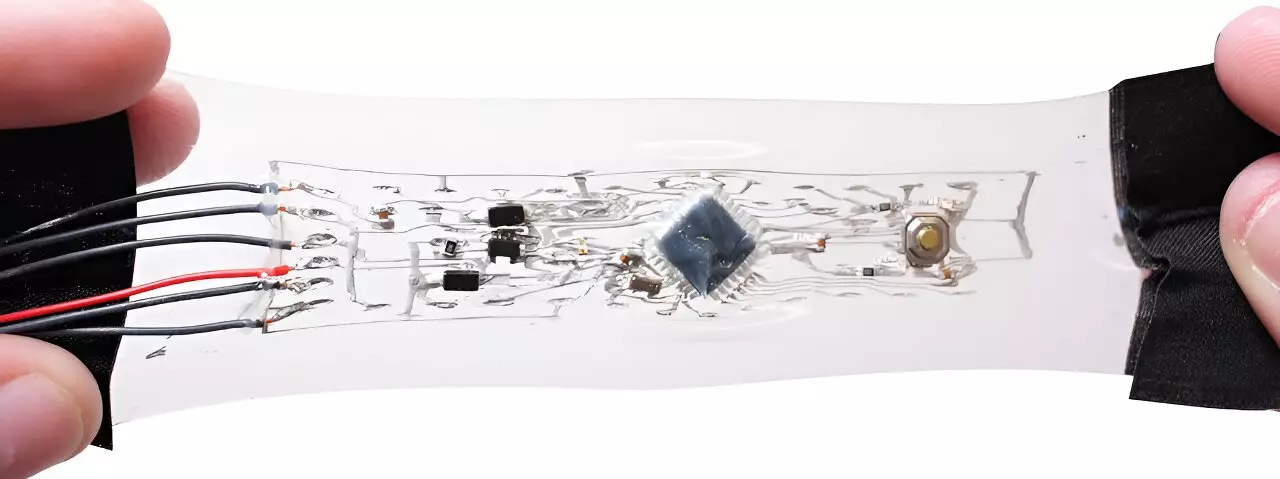The realm of soft robotics is opening a new frontier in technology, promising remarkable advancements in various fields ranging from medical applications to disaster relief. Unlike traditional robots, soft robots are designed to mimic the versatility of living organisms, boasting soft, flexible structures. However, one of the primary challenges has been creating electronic components that can endure the considerable flexing, stretching, and deformation inherent in these systems. Recent advancements, particularly those emerging from the lab of Professor Rebecca Kramer-Bottiglio, indicate a substantial leap toward solving these issues through the development of stretchable electronics that integrate seamlessly with soft robot architectures.
The breakthrough research led by Kramer-Bottiglio’s lab has spotlighted the potential of these stretchable electronics, as detailed in their publication in Science Robotics. The researchers focused on creating a version of the widely-utilized Arduino platform that retains functionality even as it stretches three to four times its original shape. This leap in engineering has opened the door for designers to rethink how electronic components can be integrated into soft robots without sacrificing the devices’ core functions. By embedding stretchable versions of Arduino directly into the soft bodies, the team has overcome a significant barrier that has previously hampered the development of such technologies.
Soft robots, by their nature, are designed to be compliant and adaptable; however, these qualities have traditionally clashed with the rigid designs of conventional electronics. Previous attempts to combine soft robotics with standard circuit boards often involved awkward placements of circuitry that sacrificed the full range of motion and flexibility. This dichotomy has limited the effectiveness of soft robots in real-world applications. In a considerable shift, Kramer-Bottiglio’s team designed their complex circuits to withstand high strain by strategically positioning the components at points where stretching would be most pronounced, thus enhancing the device’s adaptability while not compromising performance.
Manufacturing stretchable electronics has often been fraught with challenges. However, the researchers employed an innovative method using gallium-based liquid metal that transitions to a paintable paste upon exposure to oxygen. This unique process allows the material to form intricate circuit patterns, adhering strongly to both flexible and rigid components. The result is a robust circuit that can be utilized in an array of applications without necessitating extensive specialized equipment or a high degree of expertise in circuit design. By standardizing circuit creation and providing open-sourced methodologies, the research paves the way for wider accessibility and use among both professionals and hobbyists alike.
The implications of stretchable circuits are vast. In the field of robotics, these innovations are expected to enhance the functionality of soft robots in numerous ways. For example, the embedded stretchable electronics have been applied to control the gait of quadruped robots, showcasing the seamless integration of movement and functionality. Furthermore, applications extend to wearable technology, where the research has shown promise in creating devices that assist with rehabilitation, such as deploying soft circuits around joints like the elbow. This functionality aims to assist individuals recovering from injuries by monitoring movement and providing personalized feedback while accommodating natural joint dynamics.
The promising results from Kramer-Bottiglio’s lab not only signify a significant advancement in stretchable electronics but also establish a new benchmark for future research in both robotics and wearable technology. By overcoming past limitations, researchers are not merely creating isolated demonstrations, but robust, versatile prototypes that can be adapted for real-world applications. The emphasis on open-source methodologies fosters a collaborative environment, encouraging innovation across disciplines and laying the groundwork for future breakthroughs in soft robotics.
As we forge ahead, the advancements made in the integration of stretchable electronics into soft robotics signal the dawn of an era where technology is increasingly harmonized with the body’s natural capabilities. These developments stand to revolutionize numerous fields, emphasizing functionality without compromising flexibility. Such innovations will likely not only change the landscape of robotics but also impact healthcare, assistive technology, and beyond, illustrating how interdisciplinary research continues to push the boundaries of what is possible in the interconnected world of robotics and electronics.


Leave a Reply